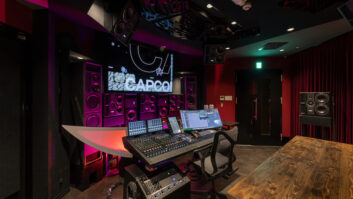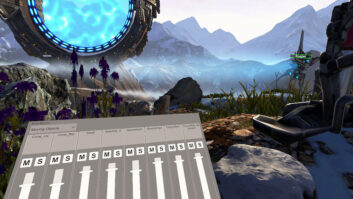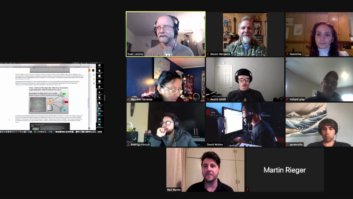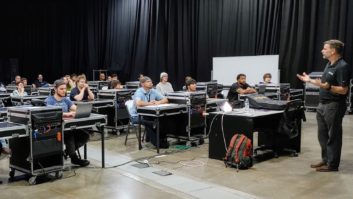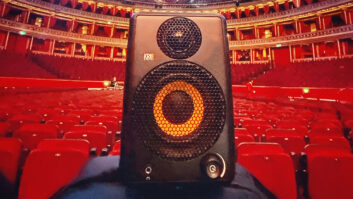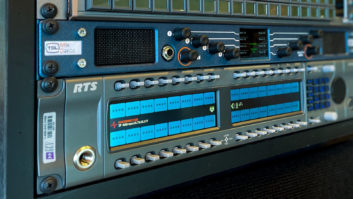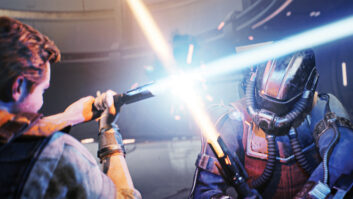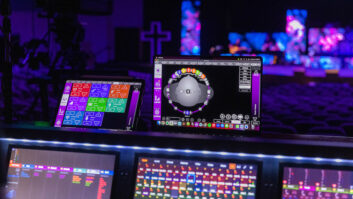Tim Hatfield (left) and Sammy Merendino in the Harlem Parlour control room NEW YORK, NY—Harlem Parlour Music Club, a “down home uptown” collective comprised of top New York-based musicians, is feeling good. The group’s recent release, Salt of the Earth, is finding a home on more and more radio playlists. Coming on the heels of A Harlem Parlour Christmas, which landed the group at No. 15 on FOLKDJ-L’s Top Artists of December 2009, HPMC is clearly on to something.

That something is, in part, the unique studio from which HPMC derives its name: the 1892 Harlem townhouse of Sammy Merendino, the longtime drummer for Cyndi Lauper who has recorded and performed with a multitude of other artists.
By virtue of the creative use of space and equipment, he and co-producer Tim Hatfield can work together from different rooms, on different floors. To call the Harlem Parlour a home studio, in fact, would not begin to do it justice: a spacious and inviting home and a fully featured recording studio—offering five separate acoustic spaces—exist in the same space.
But for a control room and a dedicated drum room, the “studio” aspects of the Harlem Parlour are mostly unseen. Patch panels for microphones and the Mytek Private Q system are behind closet doors or otherwise out of view.
“My drum room is right above the control room,” Merendino explains. “Outside of the drum room, which used to be a dining room, is the entry foyer, into which we drop a line down the stairs. In the Parlour, you open my wife’s coat closet and tucked in the back are the patch panels for the Private Q and mics. When she comes home, I can turn it back into a parlor. We record people in the kitchen as well.”
In the cellar, Hatfield adds, “There’s more mic panels and speaker cabinets. The guitar amp heads [in the control room] are plugged into different cabinets down there.” Accusound Silver Studio Pro cables make a big difference for longer runs, he adds. “The vocal sound is very clear. We don’t do many really long runs, but if the bass player has to go out in the foyer, for example, it really makes a difference.”
The Pro Tools|HD3 system can be accessed both at the control room and Merendino’s drum kit, via remote monitor and keyboard, where he also has a footswitch-activated talkback mic. “The rooms are wired for video,” he adds, “so I can see what’s going on in the different rooms.”
The Private Q system, says Hatfield, “makes it so much easier to deal with recording. With the Harlem Parlour Music Club, we usually have six or seven players—sometimes eight—and vocals all going at once. The Private Q makes it a lot easier to please that many people.”
“Plus, Merendino adds, “it takes the burden off Tim and myself. Producing from behind a drum kit, it’s easier to let everybody deal with their own headphone mixes.”
Choice equipment includes a pair of recently acquired ADK CS-251J mics, often used for drum overheads; a vintage AKG C12 that, legend has it, was used to record Nat “King” Cole at Capitol Studios; multiple API 550a and 550b EQs and 512c preamps; a Neve 1064 mic pre/EQ; a PreSonus/Anthony DeMario Labs ADL 600; and a pair of Avalon VT-737SPs.
Also essential are the Cloud Microphones Cloudlifter phantom-powered “pre-preamp” (for use with the Coles 4038 ribbon mics) and the Dangerous Music 2-Bus. “The summing has made the biggest difference in mixing,” says Merendino. “Then Tim can do parallel compression on the drums without getting any phasing and flanging. It makes a huge difference. Some people say it doesn’t, but I think it does.”
“I think it does, too,” Hatfield concurs. “Certain instruments or groups of instruments get their own outputs or converters, which I believe makes the mix clearer. For example, the vocal has its own output, as does the bass. Guitars are usually mixed in a stereo pair with sends to another pair of outputs that go to a pair of [Empirical Labs] Distressors.
“We use very little analog gear in the mix,” he adds, “but we definitely lean on the Chandler TG-1 for drums and Distressors for guitars.”
The vibe is organic, thanks to a relaxed, communal atmosphere characterized by acoustic instruments, ensemble performance, and food. (Sounds are generally recorded to analog tape before going digital, as well: An Otari MTR90 MkII occupies one corner of the control room.)
Recording usually begins around noon, Merendino explains. “Within a half-hour, we’ve pretty much got what it’s going to be. We’ll do three or four takes, generally to tape, and pick the take we like. Sometimes we’ll put an alternate take in, and dump it all to Pro Tools. At that point, it’s 90 percent done, outside of a few vocal fixes. We try to keep as much of the performance— everybody playing together— and sometimes even put the singers in with the guitars so they have to sing. We prefer not to edit it, so they’ve got to get the notes. I think it makes everybody play better.”
“We’ve done stuff live with as many as six background singers,” says Hatfield. “Three guitars, accordion, upright bass, drums, two violins and six singers, all at once. We’ve tried to overdub a couple of times and it never felt the same. One thing about doing it here is everybody is so relaxed. And it always ends the same way: We make dinner.”
“Usually,” Merendino adds, “by six o’clock, we’re done. We’ve already cut two tracks, somebody might start cooking while Tim and I are editing, or we all take turns. It becomes a communal, ‘family’ thing. There’s never really pressure to get something, because we always do.”
Harlem Parlour Music Club will perform at The Living Room in New York on April 13. The following day, they will appear on New York-based radio station, WFUV.
Harlem Parlour Music Club
harlemparlourmusicclub.com
Sammy Merendino
sammymerendino.com
Tim Hatfield
timhat.net
